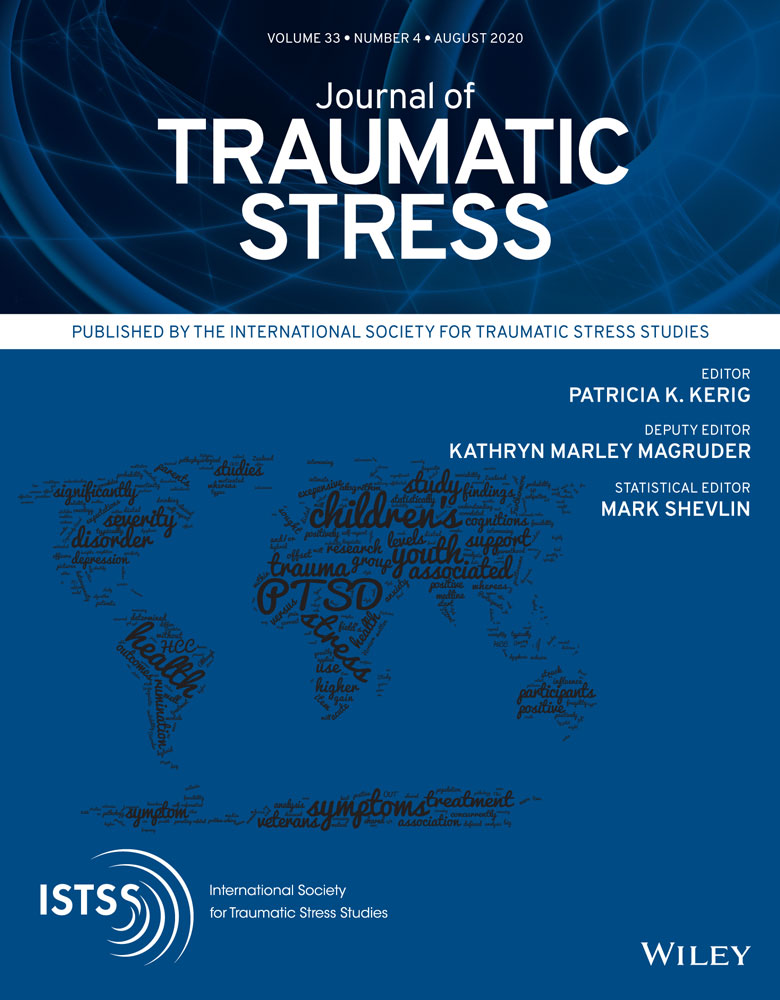Identifying Change Targets for Posttraumatic Stress Disorder Among Suicidal and Self-Injuring Women With Borderline Personality Disorder
This research was supported by the National Institute of Mental Health (R34MH082143; ClinicalTrials.gov Identifier: NCT01081314).
We would like to thank the clients, therapists, assessors, and staff at the Behavioral Research and Therapy Clinics for their contributions to this research. Drs. Harned and Schmidt are paid to provide training and consultation in dialectical behavior therapy (DBT) and DBT PE.
Abstract
enResearch on psychotherapies for posttraumatic stress disorder (PTSD) is increasingly focused on understanding not only which treatments work but why and for whom they work. The present pilot study evaluated the temporal relations between five hypothesized change targets—posttraumatic cognitions, guilt, shame, general emotion dysregulation, and experiential avoidance—and PTSD severity among women with PTSD, borderline personality disorder, and recent suicidal and/or self-injurious behaviors. Participants (N = 26) were randomized to receive 1 year of dialectical behavior therapy (DBT) with or without the DBT prolonged exposure (DBT PE) protocol for PTSD. Potential change targets and PTSD were assessed at 4-month intervals during treatment and at 3-month posttreatment follow-up. Time-lagged mixed-effects models indicated that between-person differences in all change targets except guilt were associated with more severe PTSD, η2s = .32–.55, and, except for general emotion dysregulation, slowed the rate of change in PTSD severity over time, η2s = .20–.39. In DBT but not in DBT + DBT PE, individuals with higher levels of guilt and experiential avoidance relative to their own average had more severe PTSD at the next assessment point, η2s = .12–.25. The associations between the proposed change targets and PTSD severity were not bidirectional, except for general emotion dysregulation, η2 = .50; and posttraumatic cognitions, η2 = .06. These preliminary findings suggest that trauma-related cognitions, shame, and guilt, as well as problems regulating them, may be important change targets for improving PTSD in this patient population.
抽象
zhTraditional and Simplified Chinese Abstracts by the Asian Society for Traumatic Stress Studies (AsianSTSS)
簡體及繁體中文撮要由亞洲創傷心理研究學會翻譯
Identifying Change Targets for PTSD among Suicidal and Self-Injuring Women with Borderline Personality Disorder
Traditional Chinese
標題: 在有自殺及自殘傾向的邊緣性人格障礙女性中, 辨識出治療其PTSD的改變目標
撮要: 針對創傷後壓力症(PTSD)心理治療的研究, 除了專注於了解哪種療法有效外, 亦越來越著重研究療法對哪些人有效及為何有效。本先導研究評估五種假設性的改變目標)創傷後認知、內疚、羞恥、普遍性情緒失調、經驗性迴避(跟PTSD嚴重度的時間關連。樣本為患PTSD、邊緣性人格障礙的女性, 及近期有自殺和/或自殘行為的女性。樣本(N = 26) 接受為期一年的辯證行為治療(DBT), 被隨機分派到兩組, 一組的治療包含指定針對PTSD的DBT延長暴露元素(DBT PE), 另一組則沒有。我們在樣本接受治療時, 每四個月評估一次潛在改變目標和PTSD, 並在樣本完成治療三個月後再作跟進評估。時滯混合效應模型顯示, 在所有改變目標)除了內疚(方面, 不同樣本之間的差異都跟有較嚴重的PTSD有關)η2s = .32–.55(。此外, 除了普遍性情緒失調外, 所有改變目標都減慢了PTSD嚴重度隨時間的改變)η2s = .20–.39(。在DBT組別而非DBT + DBT PE組別中, 比自己平常表現出較高水平內疚及經驗性迴避的樣本, 在下一次評估時有較嚴重的PTSD)η2s = .12–.25(。上述的改變目標跟PTSD嚴重度的關連並非雙向, 但普遍性情緒失調)η2 = .50(及創傷後認知除外)η2 = .06(。這些初步發現反映, 對於治療這類患者的PTSD, 創傷相關的認知、羞恥、內疚以及影響它們調節的問題可能屬重要的改變目標。
Simplified Chinese
标题: 在有自杀及自残倾向的边缘性人格障碍女性中, 辨识出治疗其PTSD的改变目标
撮要: 针对创伤后压力症(PTSD)心理治疗的研究, 除了专注于了解哪种疗法有效外, 亦越来越着重研究疗法对哪些人有效及为何有效。本先导研究评估五种假设性的改变目标)创伤后认知、内疚、羞耻、普遍性情绪失调、经验性回避(跟PTSD严重度的时间关连。样本为患PTSD、边缘性人格障碍的女性, 及近期有自杀和/或自残行为的女性。样本(N = 26) 接受为期一年的辩证行为治疗(DBT), 被随机分派到两组, 一组的治疗包含指定针对PTSD的DBT延长暴露元素(DBT PE), 另一组则没有。我们在样本接受治疗时, 每四个月评估一次潜在改变目标和PTSD, 并在样本完成治疗三个月后再作跟进评估。时滞混合效应模型显示, 在所有改变目标)除了内疚(方面, 不同样本之间的差异都跟有较严重的PTSD有关)η2s = .32–.55(。此外, 除了普遍性情绪失调外, 所有改变目标都减慢了PTSD严重度随时间的改变)η2s = .20–.39(。在DBT组别而非DBT + DBT PE组别中, 比自己平常表现出较高水平内疚及经验性回避的样本, 在下一次评估时有较严重的PTSD)η2s = .12–.25(。上述的改变目标跟PTSD严重度的关连并非双向, 但普遍性情绪失调)η2 = .50(及创伤后认知除外)η2 = .06(。这些初步发现反映, 对于治疗这类患者的PTSD, 创伤相关的认知、羞耻、内疚以及影响它们调节的问题可能属重要的改变目标。
Resumen
esSpanish Abstracts by Asociación Chilena de Estrés Traumático (ACET)
Identificando Objetivos de Cambio para el Trastorno de Estrés Postraumático entre Mujeres Suicidas y Autolesivas con Trastorno Límite de la Personalidad
EL TEPT LOS OBJETIVOS DE CAMBIO EN EL TRASTORNO LIMITE DE PERSONALIDAD
La investigación sobre psicoterapias para el trastorno de estrés postraumático (TEPT) se centra cada vez más en comprender no solo qué tratamientos funcionan, sino por qué y para quién funcionan. El presente estudio piloto evaluó las relaciones temporales entre cinco objetivos de cambio hipotéticos (cogniciones postraumáticas, culpa, vergüenza, desregulación general de las emociones y evitación de la experiencia) y la gravedad del TEPT entre mujeres con TEPT, trastorno límite de la personalidad y suicidio reciente y/o conductas autolesivas. Los participantes (N = 26) fueron asignados al azar para recibir 1 año de terapia conductual dialéctica (DBT en su sigla en inglés) con o sin el protocolo de exposición prolongada DBT (DBT PE en su sigla en inglés) para el TEPT. Los posibles objetivos de cambio y el TEPT se evaluaron a intervalos de 4 meses durante el tratamiento y en el seguimiento de 3 meses después del tratamiento. Los modelos de efectos mixtos con retraso en el tiempo indicaron que las diferencias entre personas en todos los objetivos de cambio, excepto la culpa, se asociaron con un TEPT más severo, η2s = .32 – .55, y, excepto por la desregulación general de las emociones, disminuyó la tasa de cambio en la gravedad del TEPT con el tiempo, η2s = .20 – .39. En DBT pero no en DBT + DBT PE, los individuos con niveles más altos de culpa y evitación experiencial en relación con su propio promedio tenían un TEPT más severo en el siguiente punto de evaluación, η2s = .12 – .25. Las asociaciones entre los objetivos de cambio propuestos y la gravedad del TEPT no fueron bidireccionales, excepto para la desregulación emocional general, η2 = .50; y cogniciones postraumáticas, η2 = .06. Estos hallazgos preliminares sugieren que las cogniciones relacionadas con el trauma, la vergüenza y la culpa, así como los problemas que las regulan, pueden ser importantes objetivos de cambio para mejorar el TEPT en esta población de pacientes.




